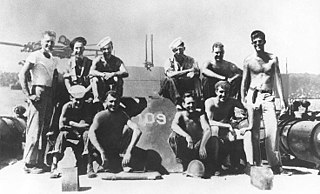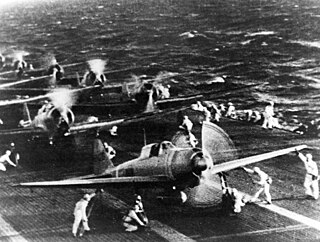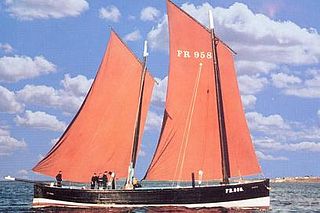
PT-109 was a PT boat last commanded by Lieutenant John F. Kennedy, future United States President, in the Pacific Theater during World War II. His actions to save his surviving crew after the sinking of PT-109 made him a war hero. PT-109's collision with a Japanese Destroyer contributed to Kennedy's long-term back problems and required months of hospitalization at Chelsea Naval Hospital. Kennedy's post-war campaigns for elected office referred often to his service on the PT-109.

An inflatable boat is a lightweight boat constructed with its sides and bow made of flexible tubes containing pressurised gas. For smaller boats, the floor and hull is often flexible, while for boats longer than 3 metres (9.8 ft), the floor typically consists of three to five rigid plywood or aluminium sheets fixed between the tubes, but not joined rigidly together. Often the transom is rigid, providing a location and structure for mounting an outboard motor.

USS Walke (DD-416) was a World War II-era Sims-class destroyer in the service of the United States Navy, named after Rear Admiral Henry A. Walke USN (1809–1896). Walke operated with the Neutrality Patrol in the Caribbean before World War II and fought in the Pacific Theater during the war before being sunk in the Naval Battle of Guadalcanal.

McHale's Navy is an American sitcom starring Ernest Borgnine that aired 138 half-hour episodes over four seasons, from October 11, 1962, to April 12, 1966, on the ABC television network. The series was filmed in black and white and originated from an hour drama entitled Seven Against the Sea, broadcast on April 3, 1962.
USS Napa (AT-32), originally Yucca, was a Bagaduce-class fleet tug of the United States Navy. The ship was laid down as Napa on 5 March 1919, at the Puget Sound Naval Shipyard, Washington; launched on 24 July 1919; and commissioned on 5 December 1919, Lt. W. R. Giddens in command.
USS Blessman (DE-69/APD-48), a Buckley-class destroyer escort of the United States Navy, was named in honor of Lieutenant Edward Martin Blessman (1907–1942), who was killed in action in the Pacific on 4 February 1942. The ship was built by the Bethlehem-Hingham Shipyard at Hingham, Massachusetts in 1943. After commissioning, Blessman escorted convoys in the North Atlantic before taking part in Operation Overlord, the Allied invasion of Northern France in June 1944. She was then converted to a High-speed transport, being fitted with accommodation and landing craft for carrying troops, while being capable of escorting amphibious groups and providing gunfire support to landing operations. After conversion, Blessman took part in the Allied invasion of the Philippines and the Battle of Iwo Jima, where she was damaged by a Japanese bomber.
Kenneth Dennis Molloy was a judge on the New York State Supreme Court.

Motor Torpedo Boat PT-59 was a PT-20-class Motor Torpedo Boat of the United States Navy, built by the Electric Launch Company of Bayonne, New Jersey. The boat was laid down as Motor Boat Submarine Chaser PTC-27, and was reclassified as BPT-11 when assigned to transfer to Britain under Lend-Lease. However, this was cancelled, and she was reclassified as PT-59 prior to launch on 8 October 1941, and was completed on 5 March 1942.

USS Bienville was a 1,558 long tons (1,583 t) (burden) wooden side-wheel paddle steamer acquired by the Union Navy early in the American Civil War. She was armed with heavy guns and assigned to the Union blockade of the waterways of the Confederate States of America.

USS LST-16 was a LST-1-class tank landing ship built for the U.S. Navy during World War II. Like most ships in her class, she was not named and was known only by her designation. She was staffed by a U.S. Coast Guard crew throughout her service career.

USS Wachapreague (AGP-8) was a motor torpedo boat tender in commission in the United States Navy from 1944 to 1946, seeing service in the latter part of World War II. After her Navy decommissioning, she was in commission in the United States Coast Guard from 1946 to 1972 as the cutter USCGC McCulloch (WAVP-386), later WHEC-386, the fourth ship of the U.S. Coast Guard or its predecessor, the United States Revenue Cutter Service, to bear the name. In 1972 she was transferred to South Vietnam and served in the Republic of Vietnam Navy as the frigate RVNS Ngô Quyền (HQ-17). Upon the collapse of South Vietnam at the end of the Vietnam War in 1975, she fled to the Philippines, and she served in the Philippine Navy from 1977 to 1985 as the frigate RPSGregorio del Pilar (PF-8) and from 1987 to 1990 as BRP Gregorio del Pilar (PF-12).

The second USS Willoughby (AGP-9) was a motor torpedo boat tender that served in the United States Navy from 1944 to 1946, seeing service in the later stages of World War II. Transferred to the United States Coast Guard in 1946, she was in commission as the cutter USCGC Gresham (WAVP-387), later WHEC-387 and WAGW-387, from 1947 to 1969 and from 1970 to 1973, seeing service in the Vietnam War during her Coast Guard career.

The June 1962 Alcatraz escape was a prison break from Alcatraz Federal Penitentiary, a maximum-security facility located on an island in San Francisco Bay, undertaken by inmates Frank Morris and John and Clarence Anglin. The three men were able to escape from their cells and leave the island in a makeshift raft. It remains unknown what happened to them after entering San Francisco Bay.

The Fitzroy was a steel-hulled steamship built in 1912 at Old Kilpatrick, Scotland in 1912. She was wrecked and lost when she capsized in a gale whilst carrying a general cargo between Coffs Harbour and Sydney off Cape Hawke, New South Wales on 26 June 1921.

An Assault boat is a boat used for making a landing in combat. Meant for inland waters, assault boats were light enough to be carried by several men and paddled, or fitted with an outboard motor for hi-speed operation, manually portable or not.

The Centerville Beach Cross is a monument that commemorates the 17 passengers and 21 crew members who died in the shipwreck of the SS Northerner on January 6, 1860. The vessel, owned by the Pacific Mail Steamship Company, struck a rock near Cape Mendocino and wrecked on Centerville Beach, in Humboldt County, California. The monument is registered as California Historical Landmark # 173.
USS APc-25 was a United States Navy APc-1 class coastal transport vessel. It was assigned to the Pacific in World War II where it transported supplies, personnel and munitions around the islands in the Southern Solomon Islands. It was under constant threat of air, sea and submarine attack.

The Herald was an iron paddle steamer imported as frames from the United Kingdom and assembled in 1855 by Richard Johnson in Sydney Harbour, New South Wales, Australia, where she was registered. The Herald is one of the earliest iron paddle wheel steamers built in Australia, where she operated within Sydney Harbour. She was initially used on the fledgling North Shore route between Dawes Point and Blues Point by the newly formed North Shore Steam Company; however, due to not enough traffic to make her financially viable, she often performed tug duties. Eventually the North Shore Steam Company was wound up; the vessel was put up for sale but continued picking up business wherever it was available, operating as a tug, ferry, excursion boat and cargo vessel.
























